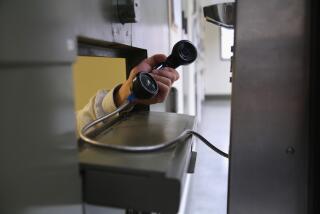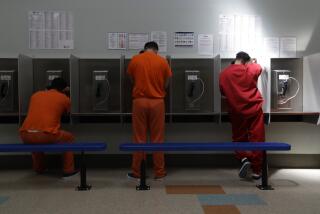ICE deliberately limited testing at Bakersfield immigration facility with COVID-19 outbreak
- Share via
Last month, as the coronavirus spread through federal immigration detention centers around the country, officials at the Mesa Verde facility in Bakersfield rejected a suggestion to test all detainees there because it would be difficult to quarantine those who tested positive, the officials said.
In an email on July 6, Janese Mull, the acting field office director for Immigration and Customs Enforcement in San Francisco, said lawyers for ICE had advised that it was in the facility’s best interest to look into conducting COVID-19 testing for all detainees.
But Brooke Sanchez Othon, a clinical operations specialist at Wellpath, a private Nashville-based healthcare company that provides services to ICE detention facilities, pushed back against Mull’s direction. The proposal to test all detainees, Sanchez Othon wrote, already had been denied “due to the housing restrictions we face.”
“Testing all detainees will potentially cause the same housing issue we had last week but on a larger scale,” Sanchez Othon continued, referring to the problem of quarantining infected detainees. “Completing the testing is not the issue it is just what we will need to do with the results once they are received.”
The email exchange, obtained by lawyers with the American Civil Liberties Union and the public defender’s office of San Francisco, reveals how ICE has failed to contain the spread of the coronavirus in its facilities, critics of the agency contend.
This week, a COVID-19 outbreak emerged at the Mesa Verde ICE Processing Center, where about 120 detainees are being held. So far, 14 staff members and nine detainees have tested positive.
Detainees and immigrant rights advocates described a chaotic situation there, with two men hospitalized since Saturday and several more displaying symptoms of the virus while being held in large dormitories with others who feared becoming infected. As test results trickled in, the staff ran out of quarantine spaces, at one point reportedly placing two men in a bathroom for hours.
Spokespeople for ICE and GEO declined to comment because of pending litigation.
On Thursday, a federal judge in San Francisco issued a searing ruling, saying that ICE has “responded to the health crisis in such a cavalier fashion” that it has “lost the right to be trusted.”
“The documentary evidence shows that the defendants have avoided widespread testing of staff and detainees at the facility, not for lack of tests, but for fear that positive test results would require them to implement safety measures that they apparently felt were not worth the trouble,” Judge Vincent Chhabria wrote in granting the temporary restraining order.
Chhabria ordered officials to administer weekly rapid COVID-19 tests to all detainees at the facility and not take in new detainees.
Emails and other documents obtained by the lawyers, who sued the federal government in April over conditions at the facility amid the pandemic, provide a rare behind-the-scenes look at conditions in the facility and ICE’s response to the novel coronavirus.
Mesa Verde has four dorms, each outfitted with enough bunk beds for 100 people. The facility has three disciplinary segregation rooms, two medical segregation rooms and three intake rooms, which don’t have beds. Before the outbreak last week, detainees alternated top and bottom bunk sleeping assignments, with one person per bed.
Detainees in dorm B demanded to be tested for days before facility staff supplied tests late last month, advocates and detainees said. In an email sent Wednesday, an attorney for the federal government said that 78 detainees in the remaining three dormitories at Mesa Verde were tested and seven others refused testing. Detainees from dorm B were moved into dorm C so that dorm B could be designated for those who test positive.
In a May 18 memo, Nathan Allen, the warden at Mesa Verde, laid out a COVID-19 testing plan. Testing would begin two days later, and detainees who refused to be tested would be held together in a dorm for 14 days. Those who tested positive would be moved to medical isolation areas or a general population living area, depending on the number of people.
“Any detainee who tests positive will be quarantined appropriately according to CDC guidelines,” he wrote.
But that plan was not executed, documents show.
Three days later, the San Francisco assistant field office director, Alexander Pham, wrote in notes from a conference call that, because of constraints that the ICE Health Service Corps guidelines would put on housing resources, “we will be limiting the scope of testing as much as possible.”
Further correspondence makes clear ICE and GEO Group’s indifference to testing, and their inability to agree on a consistent strategy, advocates said.
Another heated exchange began May 21 when Wendy Baca, the acting health service administrator for Mesa Verde, addressed by email concerns that she had with the warden’s plan for testing “street arrests” — those brought to the facility after being arrested by ICE rather than being transferred in.
Baca said that testing those detainees immediately and then releasing them to the facility’s general population right after they test negative “will not ensure COVID-19 does not make it into the facility. This is due to the incubation period (generally 14 days) needed to trigger a positive COVID-19 test result.”
Erik Bonnar, the deputy field office director for ICE in San Francisco, replied by email bluntly: “It appears GEO has no interest in conducting asymptomatic testing AND the test kits GEO secured are not the IHSC [ICE Health Service Corps] recommended type. You can’t make this ... up.”
On May 26, the warden, Allen, wrote that the acting field office director “would rather not have staff testing” because it would affect Enforcement and Removal Operations, the arm of ICE that handles deportations.
A month later, an executive with the GEO Group, the private prison company that manages the facility, scolded Allen, saying that his testing plan fell short of identifying mitigating strategies for incoming detainees who don’t consent to being tested but are placed directly into a housing unit anyway.
“We cannot just throw up our hands and say there isn’t anything we can do,” said Paul Laird, GEO’s western region vice president. “We should at minimum identify specific areas within the unit for new arrivals. Maybe it is in a row of bunks in the front, maybe in the back etc, but we can’t just scatter them throughout the unit without any controls.
“Whether it be tape on the floor, privacy curtains, or any other strategy you can identify, it would be better than just saying we are unable to do anything.”
On April 29, Chhabria ordered ICE to produce a list of detainees at serious risk of becoming infected with COVID-19 for consideration for release. Nearly 130 detainees have been ordered released by Chhabria since then. Others have been released voluntarily by ICE or on bond.
But at the same time, ICE continued bringing new detainees into the facility — about 175 since early May, lawyers said.
Detainees have been left to wonder how the outbreak began, speculating that it could have been either through staff or recent arrivals.
The first Mesa Verde staffer to test positive, on June 17, was a nurse. The first detainee tested positive at intake and remained quarantined before entering the general population on July 1.
But the virus didn’t spread until four weeks later, on July 30, when 65-year-old Yao Saeturn tested positive. He was taken to a local hospital the next day and released to his family on Monday.
Some detainees arrived from prisons with coronavirus outbreaks. One detainee who was transferred from the California Correctional Institution in Tehachapi, where more than 150 inmates have COVID-19, said that he was tested only after he requested a test. Another detainee who was transferred July 28 from Avenal State Prison, where the virus has killed two inmates, said his temperature was taken when he arrived but he wasn’t tested.
When German Najera Grajeda was transferred to Mesa Verde April 9 from the Growlersberg Conservation Camp northeast of Sacramento, he did not receive a coronavirus test.
Najera developed nausea and body aches early last week. The 33-year-old, who suffers from asthma, said he immediately requested a coronavirus test but was told that it wasn’t necessary.
He received one days later. By Monday, he was taken to medical, where a nurse told him he had COVID-19.
Najera said she told him not to tell anyone “so they wouldn’t be alarmed” and sent him back to the dorm. An hour later, they moved him to a disciplinary segregation room.
That night, he fainted and woke up in the hospital, where he was placed on oxygen and had a seizure before being discharged and taken back to Mesa Verde.
“They haven’t treated me like a human being,” Najera said. “They’re viewing this illness as if it’s not serious. They don’t fear it.”
He said things started to improve Wednesday, under pressure from lawyers. Finally, nurses began checking his temperature three times a day instead of one.
Susan Beaty, a fellow at Centro Legal de la Raza in Oakland, was one of 14 people arrested July 27 at the home of California Gov. Gavin Newsom while demanding that he halt transfers from prisons to detention facilities.
“We were there because clients and community members had been telling us for six months that the transfers are going to fuel the outbreak,” Beaty said. “A week later, here we are.”
More to Read
Sign up for Essential California
The most important California stories and recommendations in your inbox every morning.
You may occasionally receive promotional content from the Los Angeles Times.











